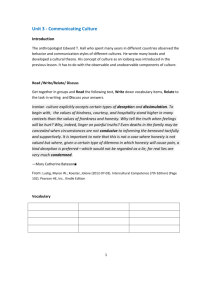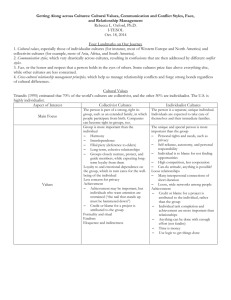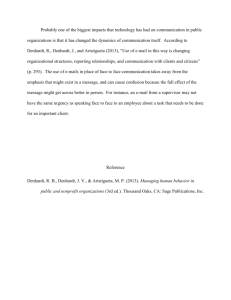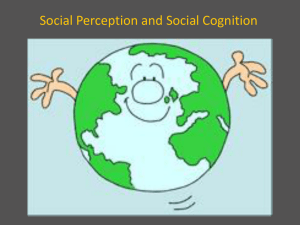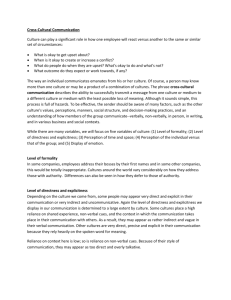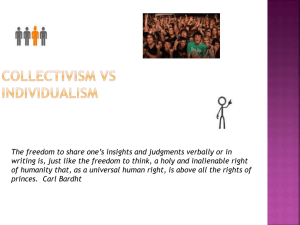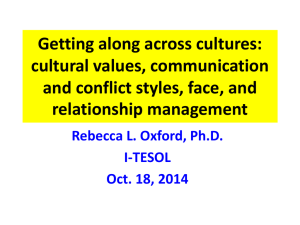Culture and Conflict: Connections
advertisement
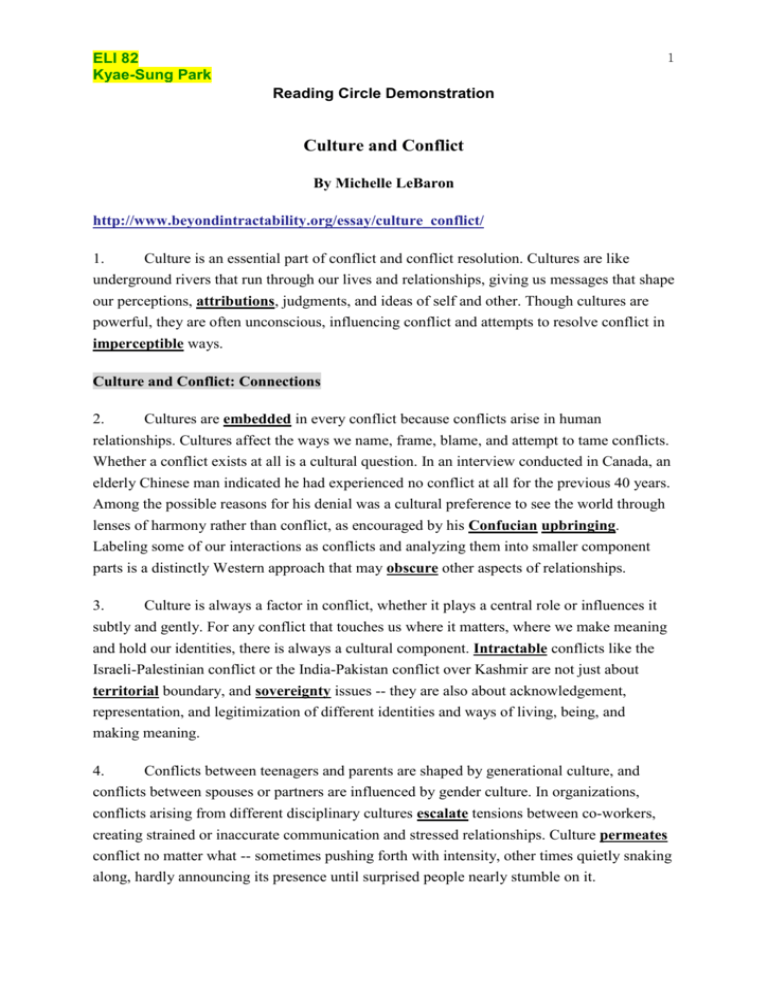
1 ELI 82 Kyae-Sung Park Reading Circle Demonstration Culture and Conflict By Michelle LeBaron http://www.beyondintractability.org/essay/culture_conflict/ 1. Culture is an essential part of conflict and conflict resolution. Cultures are like underground rivers that run through our lives and relationships, giving us messages that shape our perceptions, attributions, judgments, and ideas of self and other. Though cultures are powerful, they are often unconscious, influencing conflict and attempts to resolve conflict in imperceptible ways. Culture and Conflict: Connections 2. Cultures are embedded in every conflict because conflicts arise in human relationships. Cultures affect the ways we name, frame, blame, and attempt to tame conflicts. Whether a conflict exists at all is a cultural question. In an interview conducted in Canada, an elderly Chinese man indicated he had experienced no conflict at all for the previous 40 years. Among the possible reasons for his denial was a cultural preference to see the world through lenses of harmony rather than conflict, as encouraged by his Confucian upbringing. Labeling some of our interactions as conflicts and analyzing them into smaller component parts is a distinctly Western approach that may obscure other aspects of relationships. 3. Culture is always a factor in conflict, whether it plays a central role or influences it subtly and gently. For any conflict that touches us where it matters, where we make meaning and hold our identities, there is always a cultural component. Intractable conflicts like the Israeli-Palestinian conflict or the India-Pakistan conflict over Kashmir are not just about territorial boundary, and sovereignty issues -- they are also about acknowledgement, representation, and legitimization of different identities and ways of living, being, and making meaning. 4. Conflicts between teenagers and parents are shaped by generational culture, and conflicts between spouses or partners are influenced by gender culture. In organizations, conflicts arising from different disciplinary cultures escalate tensions between co-workers, creating strained or inaccurate communication and stressed relationships. Culture permeates conflict no matter what -- sometimes pushing forth with intensity, other times quietly snaking along, hardly announcing its presence until surprised people nearly stumble on it. 2 ELI 82 Kyae-Sung Park Culture is inextricable from conflict, though it does not cause it. When differences surface in families, organizations, or communities, culture is always present, shaping perceptions, attitudes, behaviors, and outcomes. Culture and Conflict: How to Respond 5. Given culture's important role in conflicts, what should be done to keep it in mind and include it in response plans? Cultures may act like temperamental children: complicated, elusive, and difficult to predict. Unless we develop comfort with culture as an integral part of conflict, we may find ourselves tangled in its net of complexity, limited by our own cultural lenses. Cultural fluency is a key tool for disentangling and managing multilayered, cultural conflicts. 6. Cultural fluency means familiarity with cultures: their natures, how they work, and ways they intertwine with our relationships in times of conflict and harmony. Cultural fluency means awareness of several dimensions of culture, including Communication, Ways of naming, framing, and taming conflict, Approaches to meaning making, Identities and roles. 7. Each of these is described in more detail below. Communication refers to different starting points about how to relate to and with others. There are many variations on these starting points, and they are outlined in detail in the topic Communication, Culture, and Conflict. Some of the major variations relate to the division between high- and low-context communications, a classification devised by Edward T. Hall. 8. In high-context communication, most of a message is conveyed by the context surrounding it, rather than being named explicitly in words. The physical setting, the way things are said, and shared understandings are relied upon to give communication meaning. Interactions feature formalized and stylized rituals, telegraphing ideas without spelling them out. Nonverbal cues and signals are essential to comprehension of the message. The context is trusted to communicate in the absence of verbal expressions, or sometimes in addition to them. High-context communication may help save face because it is less direct than lowcontext communication, but it may increase the possibilities of miscommunication because much of the intended message is unstated. 3 ELI 82 Kyae-Sung Park 9. Low-context communication emphasizes directness rather than relying on the context to communicate. From this starting point, verbal communication is specific and literal, and less is conveyed in implied, indirect signals. Low-context communicators tend to "say what they mean and mean what they say." Low-context communication may help prevent misunderstandings, but it can also escalate conflict because it is more confrontational than high-context communication. 10. As people communicate, they move along a continuum between high- and lowcontext. Depending on the kind of relationship, the context, and the purpose of communication, they may be more or less explicit and direct. In close relationships, communication shorthand is often used, which makes communication opaque to outsiders but perfectly clear to the parties. With strangers, the same people may choose low-context communication. 11. Low- and high-context communication refers not only to individual communication strategies, but may be used to understand cultural groups. Generally, Western cultures tend to gravitate toward low-context starting points, while Eastern and Southern cultures tend to high-context communication. Within these huge categories, there are important differences and many variations. Where high-context communication tends to be featured, it is useful to pay specific attention to nonverbal cues and the behavior of others who may know more of the unstated rules governing the communication. Where low-context communication is the norm, directness is likely to be expected in return. 12. Identities and roles refer to conceptions of the self. Am I an individual unit, autonomous, a free agent, ultimately responsible for myself? Or am I first and foremost a member of a group, weighing choices and actions by how the group will perceive them and be affected by them? Those who see themselves as separate individuals likely come from societies anthropologists call individualist. Those for whom group allegiance is primary usually come from settings anthropologists call collectivist, or communitarian. 13. In collectivist settings, the following values tend to be privileged: cooperation filial piety (respect for and deference toward elders) participation in shared progress reputation of the group interdependence In individualist settings, the following values tend to be privileged: ELI 82 Kyae-Sung Park competition 4 independence individual achievement personal growth and fulfillment self-reliance 14. When individualist and communitarian starting points influence those on either side of a conflict, escalation may result. Individualists may see no problem with "no holds barred" confrontation, while communitarian counterparts shrink from bringing dishonor or face-loss to their group by behaving in unseemly ways. Individualists may expect to make agreements with communitarians, and may feel betrayed when the latter indicate that they have to take their understandings back to a larger public or group before they can come to closure. In the end, one should remember that, as with other patterns described, most people are not purely individualist or communitarian. Rather, people tend to have individualist or communitarian starting points, depending on one's upbringing, experience, and the context of the situation. Conclusion 15. There is no one-size-fits-all approach to conflict resolution, since culture is always a factor. Cultural fluency is therefore a core competency for those who intervene in conflicts or simply want to function more effectively in their own lives and situations. Cultural fluency involves recognizing and acting respectfully from the knowledge that communication, ways of naming, framing, and taming conflict, approaches to meaning-making, and identities and roles vary across cultures. ELI 82 Kyae-Sung Park VOCABULARY LIST: N (Noun), V (Verb), A (Adjective), Adv (Adverb) 5 1. Attribution (N): assigning some quality or character to a person or thing; "the attribution of language to birds" 2. Imperceptible (A): not perceptible; not perceived by or affecting the senses 3. Confucian (A): of, pertaining to, or resembling the teachings of Confucius. Confucius: Chinese philosopher whose ideas and sayings were collected after his death and became the basis of a philosophical doctrine known a Confucianism (circa 551-478 BC). 4. Upbringing (N): the care and training of young children or a particular type of such care and training: His religious upbringing fitted him to be a missionary. 5. Obscure (V): to conceal or conceal by confusing (the meaning of a statement, poem, etc.). 6. Intractable (A): Difficult to manage or govern. 7. Territorial (A): of or pertaining to territory or land. 8. Sovereignty (N): A nation or state's supreme power within its borders. A government might respond, for example, to criticism from foreign governments of its treatment of its own citizens by citing its rights of sovereignty. 9. Escalate (V): to increase in intensity, magnitude, etc. Escalation (N) 10. Permeate (V): to pass into or through every part of: Bright sunshine permeated the room. 11. Inextricable (A): incapable of being disentangled, undone, loosed, or solved: an inextricable knot. 12. Temperamental (A): moody, irritable, or sensitive: a temperamental artist. 13. Elusive (A): difficult to describe; "a haunting elusive odor"; difficult to detect or grasp by the mind or analyze. 14. Confrontational (A): of or relating to confrontation. Confront (V): To come face to face with, especially with defiance or hostility: I wish to confront my accuser in a court of law. 15. Continuum (N): a continuous extent, series, or whole. 16. Gravitate (V): move toward; "The conversation gravitated towards politics.” 17. Allegiance (N): loyalty or devotion to some person, group, cause, or the like. 18. One-size-fits-all-approach 6 ELI 82 Kyae-Sung Park COMPREHENSION QUESTIONS 1. According to the passage, how can we define the relationship between culture and conflict? 2. What does “cultural fluency” mean? How can it be an important tool for managing cultural conflicts? 3. In his book Communication, Culture, and Conflict, Edward T. Hall classifies communication into two types. What are they? Write the features of each communication type using the following table. Type A ( ) Type B ( ) How a message is delivered Important signals or cues Advantages Eastern or Southern culture vs. Western culture 4. How are individualist and collectivist different? Under each setting, what values are privileged? Individualist Collectivist DISCUSSION QUESTIONS 1. Have you ever experienced any cross-cultural conflict before? If so, share your experience with your classmates. 2. When you came to the States for the first time in your life, what was so strange or unfamiliar to you that you could not understand it from your own cultural perspective? 3. When you encountered a cultural shock or cultural conflict, how could you overcome or manage it?
